
| Photos at the old Ferd and Rosa Busch farm near Berlin ND (unless otherwise noted, all photos are from 2004 or 2005). More farm photos 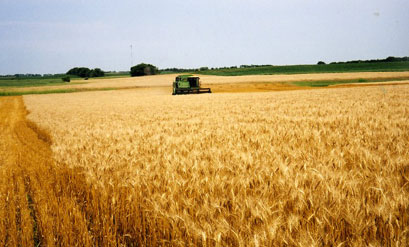 Wheat Harvest: "Amber Waves of Grain" as Vincent Busch harvests his ND wheat in 2004. Staple crops in recent years are wheat, soybeans and corn. 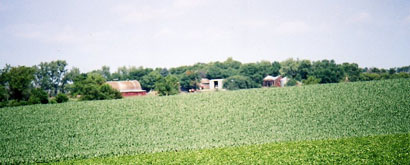 Busch Farm from southeast: This July 2005 view of the Busch farm is from the southeast, and would have been the approximate view the Berning's would have had of the farm from less than a mile to the ESE. The field in foreground is soybeans. 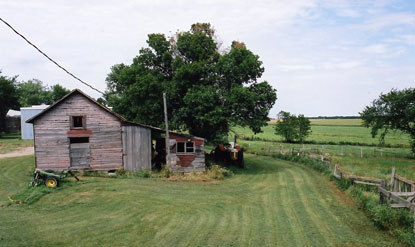 The Granary: This July 2005 photo shows the only original building left on the Busch farmstead, the granary, built the first summer of 1905. This view is looking north, from the present barn. From 1905-15, the original barn would have been just behind and to the right of this granary, blocking the view of the two small trees in the background. The farm house would have been to the left about 200 feet. 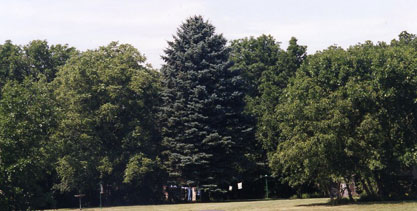 The Farmyard: This 2005 view is to the northwest. The pine tree in the center was planted in 1947 just north of the original farmhouse, very near the windcharger, which was an early source of electricity for the house. It was one of several pine trees planted at the same time, and the only one to survive. 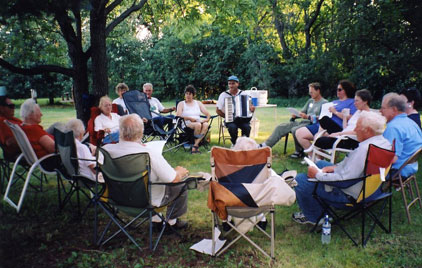 Reunion: A group of family gathered July 9-10 2005 for a small reunion at the farm, and in the evening of a hot day engaged in a traditional family sing-a-long in the shade of a black walnut and an apple tree. Playing accordion is Gerald Stangl, a Berning family descendant from Sinsinawa WI. 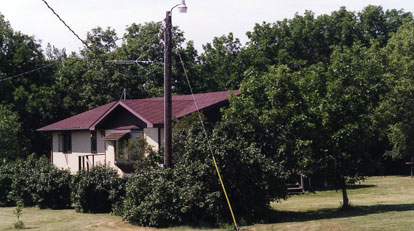 The present home: Vincent and Edithe, brother and sister, live in this home, built in 1992, just feet from the site of the original house in which they were born in 1925 and 1920 respectively. 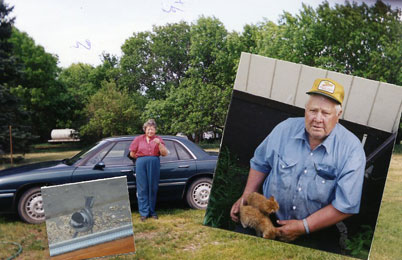 Vincent and Edithe and Friends: These photos, taken by Vince and Edithe respectively in 2002, show them at home. Birds, cats, and the very ailing (in 2005) farm dog, Sam, are important parts of their farm home environment. 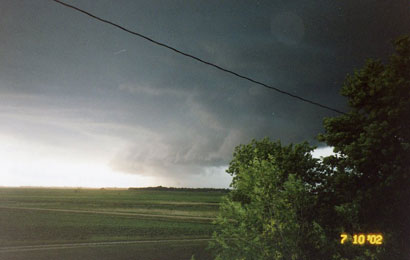 Weather, July, 2002 photo by Vincent looking southwest towards Berlin. His words: "The cloud taken from south porch shortly before severe hail and tornadic winds destroyed crops and broke windows in Berlin area. Damage area was four miles wide, 10 miles long. Elevator bins bent on roof of big Berlin Elevator. Three trailer houses ruined, one car $9000 damage. Machine sheds were ruined. Houses moved. Three tornadoes were reported seen in middle of it, etc." Later Vince described cattle being caught in this immense hail storm, unable to get to any shelter. They suffered major crop damage. 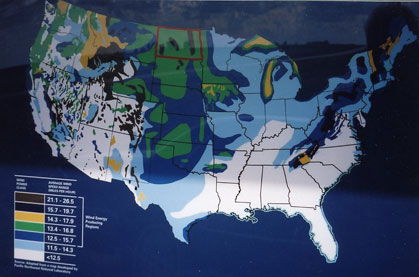 Letters to the farm in 1905 more than once inquired about the wind. They had heard North Dakota was a windy place. In 2005, 25 miles or so west of the farm, a wind energy company has a display with a map of the United States. The windiest state in the U.S.? North Dakota. 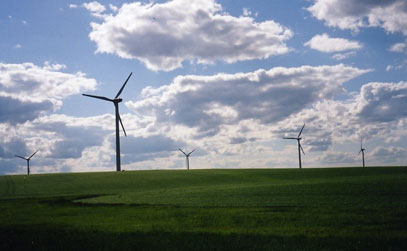 Wind Energy farm between Edgeley and Kulm ND. There are over 50 functioning wind towers at this time. 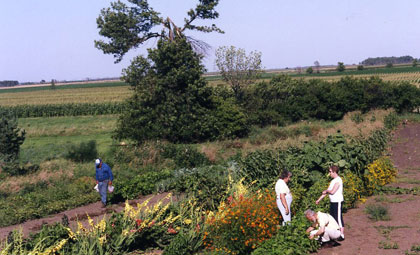 Vincent (at left) and Edithe with visitors Mary and Bob in the farm garden in August 2005. This one acre plot has been used as a garden for the entire history of the farm. The odd looking tree in the background? It survived, barely, an encounter with what probably was a small tornado. 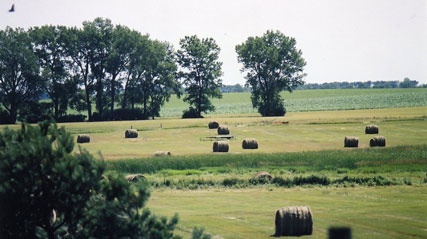 Looking east across the now unused pasture. The 61 acre pasture has never been plowed - virgin soil. The natural hay is highly desirable for livestock. The trees in the background were planted by a WPA crew in about 1934. Fred Busch had hoped for a ten acre shelterbelt, but relatively few of the trees survived. 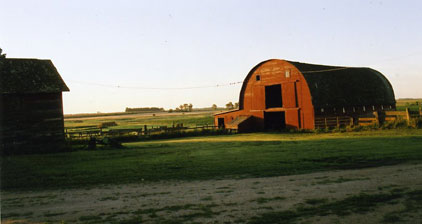 A 2005 photo of the now unused barn not long after sunrise. The trees past the barn are at the old Berning place. 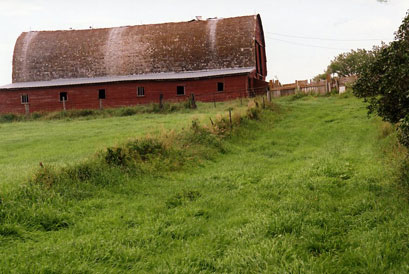 The lane to the barn, long used by thousands upon thousands of cattle going to be milked or for shelter. Busch's ceased raising cattle in the bad winter of 1996-97, the seeming never ending blizzards turned out to be too much. 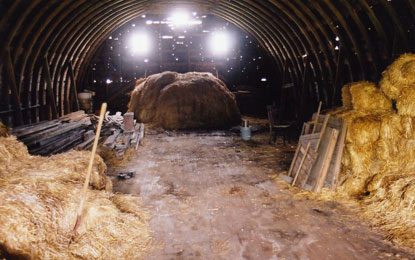 The haymow of the barn. The roof of this barn blew off in 1949, and the beams you see in the photo were hand-built, one at a time, with 1x4 pine wood, mostly by Vincent, Fred Busch, and Henry Bernard. Haymows had their utility. They were also places for adventures! And this one, like others, may have occasionally been a dance floor! Fred Busch was a fiddler. 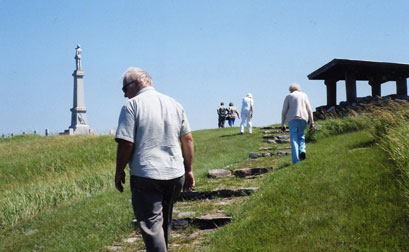 Perhaps 45 miles southwest of the farm, 15 miles south of the wind energy farm, is Whitestone Hill Monument. Here in September, 1863 occurred the greatest massacre of Indians in American history - 150 - 300 Indian men, women and children preparing buffalo for winter food. The monument is to the 20 soldiers who died; much later, a boulder was placed to honor the Indians who had died. Family members Dave Stangl, his mother Lucina Stangl, her sister Marion Placke, and others, are shown walking to the monument July 9, 2005. Google Whitestone Hill for more information. 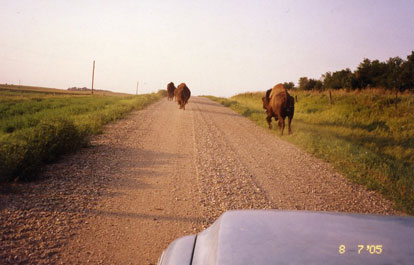 From the buffalo to the buffalo: Photo of the south end of some buffalo going north, by Vincent Busch August 7, 2005, just west of the Busch home. Vince: "About three o'clock on Sunday a herd of about 30 buffalo entered my soybean field. Two fighting bulls knocked down thirty feet of Shockman's fence. The whole herd escaped. The buffalo don't drive worth a darn. It took till 8:00 to get them out of my field and back in the fence. The two bulls had a real go at each other in my pasture. I was within 50 feet of them." 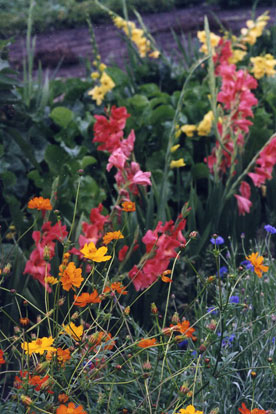 Edithe's flowers, July, 2005 | ||||||||||||||||||||||||||||||||||||||||||||||||||||||||||||||||||||||||||||||||||||||||||||

